The V5-6000 FAQ
This FAQ page will cover some history and technical data regarding the 3dfx V5-6000.
The old V5-6000 group message board is here: http://p068.ezboard.com/bvoodoo56000resourcegroup
Sign up and start posting!
I'd love to hear feedback, suggestions, corrections and additional information! Please feel to e-mail.
History- The VSA-100 family was introduced at Comdex '99 computer hardware show on November 17, 1999. Shown at the show were three boards, a 4500, a 5500 and the 6000 shown below. None of the boards were functional items, they were just static displays to show the press.
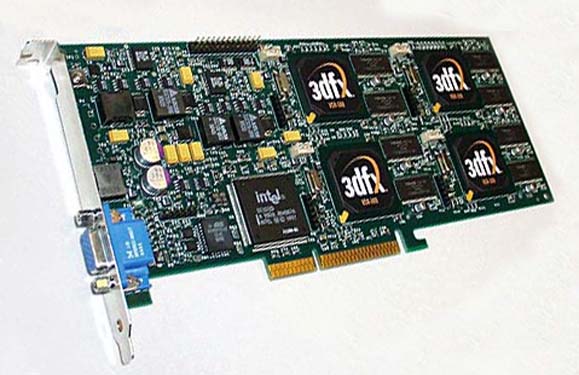
The Comdex'99 V5-6000 was a mock up board that did not and could not function.
Trivia #1- A Japanese tech site covering Comdex'99 mistakenly called the Comdex V5-6000 a 6500. 3dfx documents prior and after Comdex'99 clearly identify the board as a V5-6000.
Trivia #2- The 6000 was planned from the inception of the VSA-100 chip family. 3dfx was working on testing power supplies for the V6K as far back as the 36th week of 1999, 10 weeks before the VSA-100 chip was even announced at Comdex'99 and the mock up cards shown.
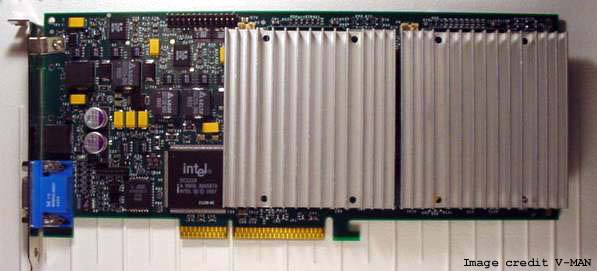
Trivia #3- Only two Comdex V6K were known to exist, for "the dog and pony show" as one engineer put it. They were strictly for photo-ops till the real thing could be produced. Shown above is a rare picture from 3dfx showing a Comdex'99 V6K with what looks like uncut V3-3000 heatsinks.
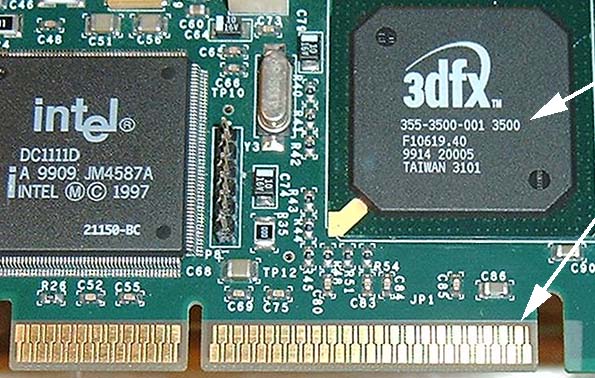
Trivia #4- The Comdex '99 was a dummy PCB populated with components with no traces or connections, even the AGP connector contacts just stop.
Trivia #5- The Comdex '99 boards has 4 Voodoo 3-3500 chips! Hence the VSA-100 decals covering the chips during the show.
Voodoo Volts- Odd as it seems now in the current age of computers, the original V5-6000 included an external power supply. The reason for this was back in 1999-2000 the average PC power supply was a wimpy 200 watts compared to today's 400-600 watt high performance monsters! The V6K at full load pulls a reported 50 or 60 watts of power and in 1999 to ensure adequate operation an external brick was the solution chosen. Shown below are the two versions, one is for the early boards with four pin connector, the other for the later cards with the single pin with ground on the outside of the barrel. In either case both bricks provide 12V positive and a ground.
Don't have a brick to run your V6K? See the section below regarding internal power hookups.
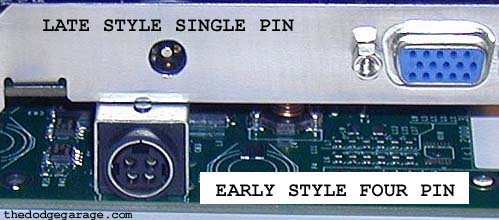
Close up of early and late power connectors on V6K PCB.
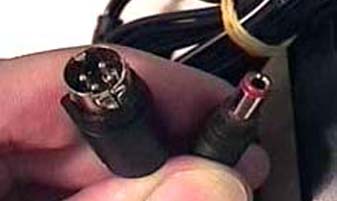
Close up of power connectors from early and late Voodoo Volts.
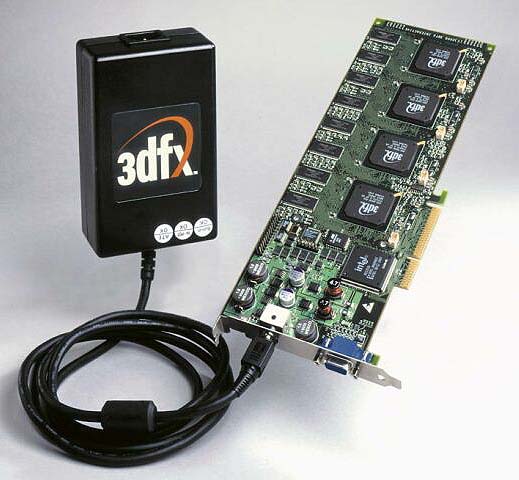
Early Voodoo Volts (Celestia, rated 12V @ 10amps) shown with Intel revision 1 V6K.
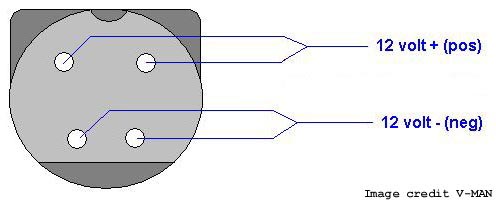
Pin out schematic of early Voodoo Volts
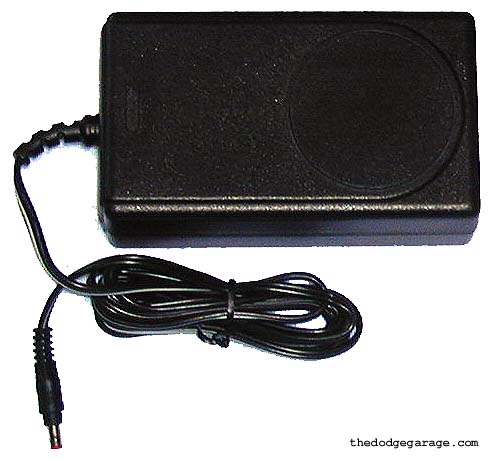
Later "single pin" Voodoo Volts, (Ault inc., rated 12 volts @ 4.6 amps)
Note- Not all bricks had 3dfx decals on them, just most of the units that were shown to the press or used in photo-ops.
Note- One hardware site tested a V5-6000, and found it pulled 48 watts through the Molex connection under full load. Of course the card also pulls some power through the AGP slot for other functions and the AGP 1/2x spec provides for up to 25 watts of power... so the reported 50-60 watts of power is right in the ballpark.
Note- In an interview September 2000, Scott Sellers of 3dfx indicated the V5-6000 pulled 50 watts of power. Based on the two figures that I have heard, does the early higher clocked 183 mhz cards pull 60 watts and the later cards 166 mhz boards pull 50 watts?
Quote from former STB employee: The second design power supply was taken from the Galileo dual flat panel monitors that the Specialized Technology Group (from within STB) had developed. We had them in stock so we used them. Most of the early ones had 3dfx stickers over the STB logo.
Voodoo Volts dynamic load testing V3 board
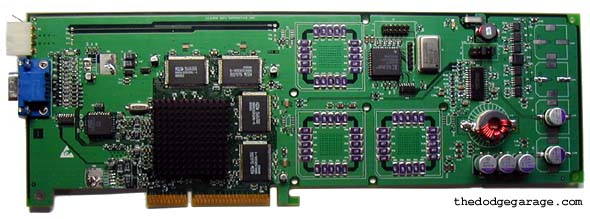
Proof that the V5-6000 wasn't an afterthought in the VSA-100 program is shown here: Your looking at a Voodoo Volts dynamic load test board dated 36-99! The date of this item pre-dates ANY of the VSA-100 engineering samples by 8 weeks.
As explained to me by the engineer responsible for the program, 3dfx was very concerned about clean power supply available to the V6K. This board would test various external power supplies and dynamically load them as if connected to a real V5-6000 which didn't even exist yet!
The PCB shown above has a Voodoo 3 chipset on board with 8MB of SGRAM and is powered up through the external "mini Molex" connector above the VGA connector.
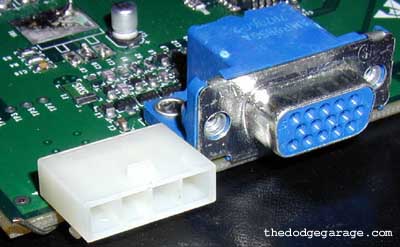
If you look close at the Comdex '99 mock up, you will see a spot on the PCB above the VGA connector for a mini Molex connector just like this one.
A note on revisions-
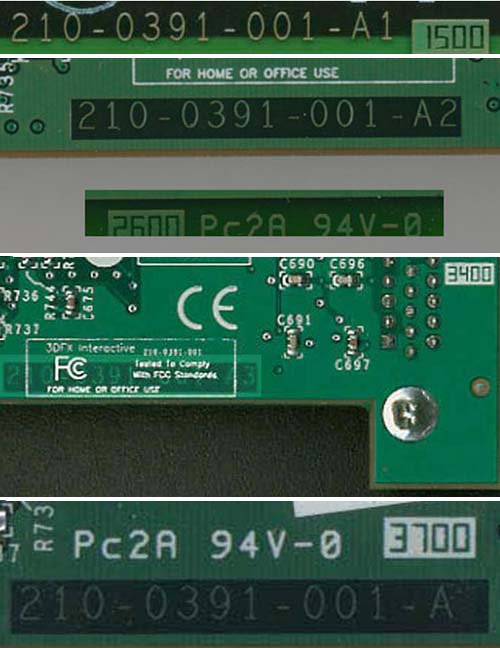
Most people refer to the boards by the PCB date as the actual revision which is actually the date the PCB was manufactured, not the revision of the board. The date will be in a white block most of the time in the following four digit format: week and year. "3900" would refer to the 39th week of the year 2000 which is roughly October 25th, 2000. The actual board revision is a series of numbers in copper followed by a letter/number prefix. As you can see in the examples above you will see a board date in a silkscreen white block and PCB number and revision in a darker block.
Hank Semenec quotes- "3700 (date) is a marker added by PCB manufacturer at the time. The final revision number is etched in copper on the back side by the AGP connector. And the number is 210-0391-001-A. This is the card from the pre-production run in Mexico."
Revisions- Shown below are the functioning versions of the V6K.
A good deal of the FAQ information and pictures below is courtesy of the now defunct V5-6000 support website run by Logical Madness. I don't agree 100% with all the information provided and will note areas of disagreement which are based on my own experiences with the V5-6000.
0700-A0 & 1500-A1 Series FAQ and data sheet.
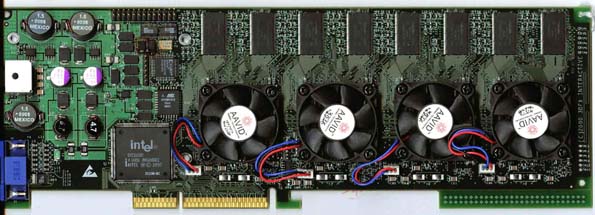
* x4 VSA-100 processors default clocked at 143mhz
(every 1500 I have seen running is at 166mhz or 167mhz)
* 128mb of 5.4ns SDRAM
* Intel bridge chip
* Old style proprietary 3dfx 'Voodoo Volts' (+12v) power supply
The Revision 1 series of voodoo 5 6000 cards were the first functioning units ever produced. Distinguishable by the presence of a larger 'Intel' bridge chip located in the bottom left corner of the card, a lot if not most of these cards were not 100% operational or stable when released, and served mainly as prototype display cards for press photos. These cards, being 'Alpha' in PCB design, suffered from many design flaws and compatibility issues, and had undergone a number of revision updates. Due to lack of concrete information, details of the cards changes are as of yet undocumented.
Known issues:
* Broken Analog SLI; SLI bands out of alignment. Known to affect all Intel based 6000's
* Motherboard chipset compatibility issues. non-video POST beeps reported on various non-'Intel' based motherboards, failure to run on early Intel motherboards due to bug.
* Power supply / video card burnout issues related to +12v proprietary 3dfx power supply.
* VSA-100 chip burnout or short life expectancy issues when clocked over 143mhz.
* Reported Unstable operation at 143mhz or above. NOTE: Some Intel based 6000's have been reported good at 166mhz, while most (probably earlier model Intel's) will only work at 143mhz and below - depends on individual card
* Rare proprietary 3dfx power supply REQUIRED for operation. (Internal hookup possible through hardware modification.
NOTE- Not all boards have "flap" shown in picture above, most of the time it is snapped off after the boards are finished.
NOTE- The Intel version V5-6000 uses unique VSA-100 drivers due to the Intel bridge chip not having a pixel clock generator on the outside. August 2000 or earlier VSA-100 drivers are required.
TRIVIA- Only one batch of Intel boards were made, "promo mainly," maybe 100+ was the estimate..
Hank Semenec quotes- "The failure of the Intel revision board to work on early Intel motherboards is caused by a bug- The Intel AGP port runs configuration cycle on itself for DEV 0 so both devices compete for the CFG cycle and lock. The Hint chips did not have this problem, indeed I'm told they were redesigned by Hint to avoid it."
3/2012 Update- I have a functioning 1500 which works on an Abit VA6 (VIA based) motherboard, no boot with an Intel board and no boot with another VIA board. Clearly not all non-Intel motherboards are suitable.
One
"1500" owner (Tom) reports success with a MSI KT3 Ultra-ARU under
Windows 98 and Gino reports the Tyan Tiger MPX S2466 works with his "1500"
2600-A2 Series FAQ and data sheet
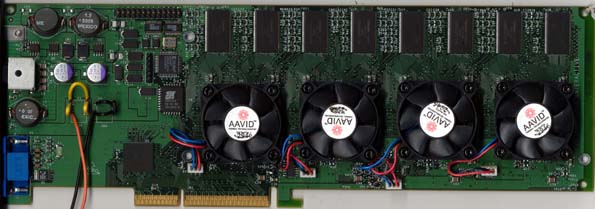
* x4 VSA-100 processors default clocked at 183mhz
* 128mb of 5.5ns SDRAM
* HiNT SLI bridge chip
* Old style proprietary 3dfx 'Voodoo Volts' (+12v) power supply
* Internal power (+12v) (Ground) hookup capable
The Revision 2 series of voodoo 5 6000 cards were the first to undergo changes that fixed issues discovered from the Revision 1 series of cards. Most notably, the Intel bridge chip on the revision 1 cards were replaced with a HiNT bridge chip on these models to solve severe motherboard compatibility issues. Other noteworthy changes were the addition of an internal hookup which allowed the card to be powered via the systems PSU, rather than using the old proprietary 3dfx power supplies which otherwise would be needed to work this revision of card. We've had very positive feedback from these revisions of cards. Reports have been from various cards in 100% working condition running stable at 183mhz and powered internally. Several issues which have been bothering other users of Revision 3 and 4 cards don't seem to be present in these models, so if you have a good working revision 2 card, congrats. Also take note that these revisions of cards used faster SDRAM than in later models, so the cards have a better success rate when clocked at their desired 183mhz speed.
Known issues:
* Motherboard chipset compatibility issues. non-video POST beeps reported on various early 'Intel' and 'SiS' based motherboards. 'VIA' chipset based motherboards recommended.
* FSAA Lockup issues on many makes of 6000 cards. Problems with voltage regulation not worked out until final retail revisions. Common issue. symptoms consist of random lockups when using any FSAA settings. Currently no workaround
* Power supply / video card burnout issues related to use of non-3dfx type power supplies. (Internal hookup recommended)
* VSA-100 chip short life expectancy issues when clocked over 183mhz.
NOTE- I have had zero problems running V5-6000 on BX based Intel boards.
Trivia- The number of these boards made is unknown at this time, but there is a notable number in circulation.
3400-A3 Series FAQ and data sheet
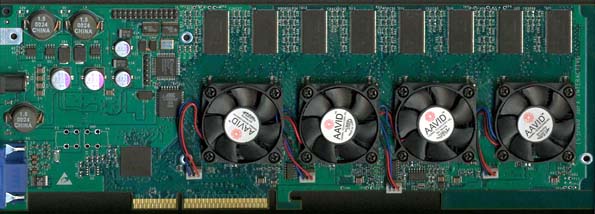
* x4 VSA-100 processors default clocked at 183 or 166mhz (depending on RAM and BIOS)
* 128mb of 5.4ns or 6.0ns SDRAM
* HiNT SLI bridge chip
* Newer style 'Voodoo Volts' (+12v) (Ground) power supply
* Internal power (+12v) (Ground) hookup capable
The Revision 3 series of voodoo 5 6000 cards were the models to have gone through the most updates and changes for their make of cards. Many more of these were made than previous models, and many of the cosmetic changes and improvements done throughout the 6000's history can be seen here. Operation and stability greatly varies with this series from card to card (the later revision, the better) Reports from these cards have been from %100 operational, to non-functional for many different reasons.
Known issues:
* Motherboard chipset compatibility issues. non-video POST beeps reported on various early 'Intel' and 'SiS' based motherboards. 'VIA' chipset based motherboards recommended.
* FSAA Lockup issues on many makes of 6000 cards. Problems with voltage regulation not worked out until final retail revisions. Common issue. symptoms consist of random lockups when using any FSAA settings.
* Power supply / video card burnout issues related to use of non-3dfx type power supplies.
* VSA-100 chip short life expectancy issues when clocked over 183mhz.
NOTE- Not all boards have "flap" shown in picture above, most of the time it is snapped off after the boards are finished.
NOTE- I have had zero problems running V5-6000 on BX based Intel boards.
Trivia- Several hundred of these boards are known to have been made, but noted to have flaws.
3700-A Series FAQ and data sheet
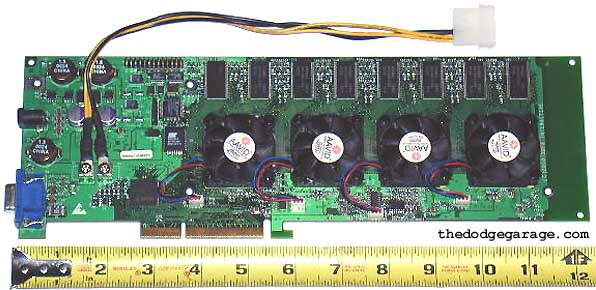
* x4 VSA-100 processors default clocked
at 166mhz
* 128mb of 6ns SDRAM
* HiNT SLI bridge chip
* Newer style 'Voodoo Volts' (+12v) (Ground) power supply
* Internal power (+12v) (Ground) hookup capable
Several hundred of these cards were made, but did not see the light of day and instead were sold to a third party graphics vendor for use, making them almost completely unavailable to the general public. Most if not all instability and or operational issues had been worked out by this revision type. If your lucky enough to own an operational make of this series, CONSIDER YOURSELF LUCKY!
Known issues:
* Possible motherboard chipset compatibility issues. 'VIA' chipset based motherboards recommended.
* FSAA Lockup issues on many makes of 6000 cards. Problems with voltage regulation not worked out until final retail revisions. Common issue. symptoms consist of random lockups when using any FSAA settings. Fixed with PCI rework, see PCI rework notes below.
* Power supply / video card burnout issues related to use of non-3dfx type power supplies.
* VSA-100 chip short life expectancy issues when clocked over 166mhz.
NOTE #1- Have had zero problems running V5-6000 on BX based Intel boards.
NOTE #2- I disagree with short VSA-100 chip life running over 166mhz, the design draft for the VSA-100 chip was to be run at 183 mhz! The only reason the boards were run at 166mhz was the mistaken thought that the high speeds were causing instability during Anti-Aliasing mode use and this turned out to not be true. The early boards have fast ram reflecting the early desire to run at 183mhz per spec. By the time of the 3600-3700 boards the VSA-100 manufacturing had settled down and was starting to mature making chances of chip burn out unlikely.
Trivia- Several hundred known to have been made and considered the best of all the revisions.
Hank Semenec quotes-"The 3700 card is also populated with A3 revision silicon, which fixed several bugs. The memory is -6 Hyundai. Feedback to voltage controller was fixed and power supply noise to display PLL was corrected."
3900-A Series FAQ and data sheet
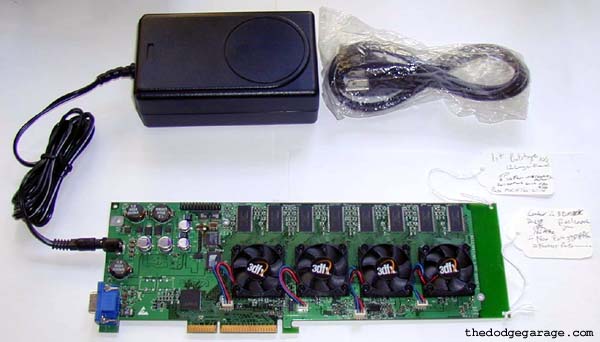
* x4 VSA-100 processors default clocked at 166mhz
* 128mb of 6ns SDRAM
* HiNT SLI bridge chip
* Newer style 'Voodoo Volts' (+12v) (Ground) power supply
* Internal power (+12v) (Ground) hookup capable
Very little is known about the "3900" series of boards or why they came into being. The board shown above is one of two known to exist, the engineer who provided the board indicated it was from "a small run" made on October 25th 2000. The engineering tags indicate it is the first prototype of the 3900 series and has a 12 layer PCB.
As an electronics laymen I know one reason PCB thickness is increased is to reduce electrical signal noise, the thicker PCB of this revision may have been a shotgun attempt to quash the instability when running in 2/4/8 Anti-Aliasing modes.
Trivia- A former employee of 3dfx indicates that typically when a batch of engineering samples were done that usually 10 were run off but never more then 20. So chances are that 10-20 of this revision were made back in October of 2000, but as to how many remain is still a mystery.
This is the last known revision of the V5-6000, 3dfx closed doors 45 days after this run was completed.
Internal PCI bus rework
(click for larger image in new window)
Background- The V5-6000 has a fundamental flaw in the board design; When the PCB was laid out, the internal routing for the PCI bus traces were run against the VSA-100 2.9 V core voltage plane. The PCI bus refers to the internal network that the VSA-100 chips and HiNT chip passes data back and forth. The PCI traces do not have reliable signal return, it is like transmitting signal on a single wire without a ground reference. The most noted issue was board instability when running in anti-aliasing modes, the noise on the bus would cause crashes and lockups. One attempted fix was to lower the VSA-100 speeds from 183 mhz to 166 mhz, unfortunately this still did not address the issue and the problem remained .
The "PCI rework" as it is known is a fix by ex-3dfx engineer Hank Semenec to bring stability to the V6K so it can function in all modes. The rework applies to PCB versions 210-0391-001-A and 210-0391-001-A3, it also might work on other revisions but has not been tested. The fix was not suitable for production use as it disables a circuit that compensates for process shift in the VSA-100 silicon from production lot to production lot. It changes the PCI clock alignment with respect to control and data signals from the HiNT bridge to VSA-100's, it gives more setup time for the signals.
The actual hardware changes involve adding 4.7k resistors at locations RR540, R589, R717, R714 and changing the 22ohm resistors to 0 ohm resistors at the following locations – R734, R743, R735, R745. Hank indicated it took him about 60 hours of time over a 3 month period to come up with the fix and walks a fine line between working and not. Hank indicated another shift in the PCI clock as small as 1 nano-second would render the board non-functional.
(click for larger image in new window)
The PCI rework does not work all the time, so there is a second level to it, the clock line to chip 1 has to be shortened, that is why sometime there is a wire added to the back of some boards.
Hank Semenec quotes- "3DFX originally thought that the chips were not stable at 183 so they decided to ship at 166, that is why rev A has -6 memory. Well, the problem was not on memory but on secondary PCI bus, so going lower did not help."
Hank Semenec technical quotes- This rework changes secondary PCI clock alignment and timing, to improve timing margin. Boards that used to fail within 30 seconds to 2 minutes completed over night runs on Quake 3 and (RWB2.3.2) GVT demo loop at 4xFSAA and 8xFSAA.
Hank Semenec technical quotes- "The high speed current return path runs directly under each trace, the reference plane must be GROUND at IO voltage (3.3V)
Hank Semenec technical quotes- (In regards to PCI rework suitability for other revisions) I would have to check the resistor positions, they will be located in the same spot but with different reference designators.
The 3700-A with the "PCI rework" is a solid performer with robust stability, pity the underlying problem was not found sooner. The two 3700 boards I own with the PCI rework are dead stable at 166-183 mhz under any anti-aliasing mode, screen resolution or color depth I have tried.
Internal Power Guide & power supplies
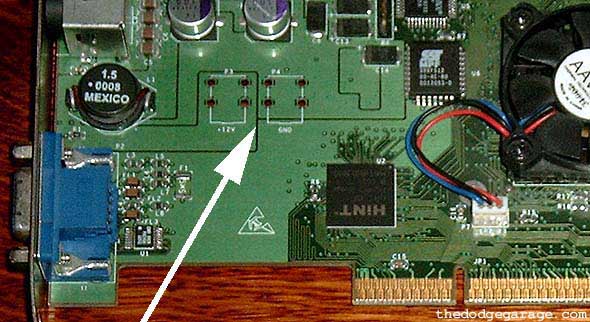
One major obstacle into getting a V5-6000 up in running is the distinct lack of Voodoo Volts available to power the card. As luck would have it someone at 3dfx must have considered powering the boards from an internal source and all Revision 2+ boards have a spot for an internal connector. If you have an "Intel" revision board there is no internal power location, but chances are the board doesn't function anyway.
Your job then is simple: All you have to do is provide the proper 12V+ and ground connections and you will be ready for some pixel pushing operation.
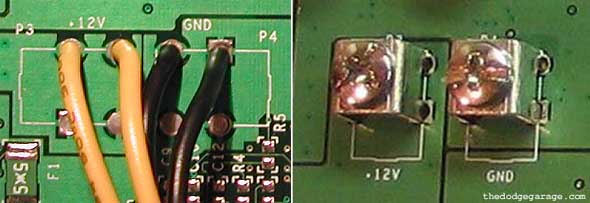
There are two ways you can go about this; you can either solder internal power supply wiring directly to the board or add terminals of some sort for a neater, more robust connection. I prefer the terminals myself as they have more contact points and look neater. This really isn't rocket science in either case if you can handle a soldering iron. You want to take a Molex connector and run the black leads (ground) to the GND pin location and the yellow leads (12+ volts) to the +12V pin location. It's best to use two wires for both locations to make sure you have adequate current path, 16 gauge wire is best if you can find it but 18 gauge will work in a pinch.
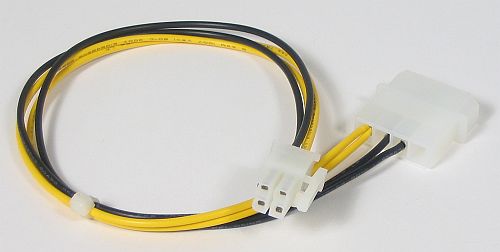
Hank Semenec indicates his leads come from a ATX power supply to P4 Motherboard power adapter cable. The P4 motherboards have a mandatory square 4 pin power connector that is required for operation, hence the adapter for ATX power supplies missing them. A quick Google search shows many vendors with these cable for sale at a few bucks a pop. Lop the 4 pin plug off, solder direct to the board or add eyelets and you are ready to go.
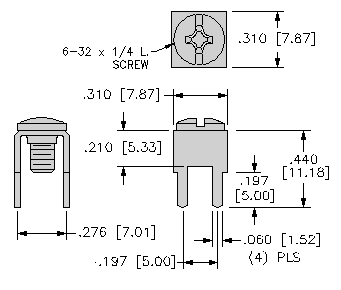
Terminals can be obtained from Keystone Electronics Corp. and the direct link to product is here, part number 8191. Eyelets for the wiring can be obtained from Radio Shack or any other supply store. If using eyelets make sure the crimp connections are tight or solder the wiring to the eyelets.
A note on required power supplies
There is a lot of rumor and speculation regarding what constitutes an acceptable power supply for use with a V5-6000 modified for use without a Voodoo Volts. Lets look at the known facts and separate them from fiction ;-)
1) What is the *maximum* amount of current that the AGP x2 spec calls for? 25 watts.
2) What is the *maximum* rated current for the later Voodoo Volts? 55 watts.
55 + 25 watts = 80 watts or 6.67 amps @ 12 volts.
Now mind you no electrical engineer in there right mind builds a part to be operated at 100% like the above scenario. Typically 80-85% is the industry norm for such things and if you subtract 15-20% off of 80 watts you come up with the number 64-68 watts of power drawn maximum. This dovetails nicely with the testing done by another site showing a 3700-A pulling 48 watts maximum through just the Molex connector running to the V6K and the reported 60 watt maximum total draw noted in interviews with 3dfx employees.
So what does all this technical gibberish mean to you?
Well since the later Voodoo Volts is rated 4.6 amps at 12 volts (55 watts) all you need is a power supply that will provide the same amount of amps at the Molex connector. Checking the specs of an Enhance Invasion 460 W show the 12 volt feeds capable of supplying a minimum of 14 amps! This is far in excess of what is required to power a V5-6000, indeed the latest specs for the Nvidia 7800 GTX call only for a 385 watt power supply. My advice to you is to check to and see what your power supply can provide on one of the 12 volt lines, if it is 5 amps or greater then you will should have no problems.
My personal experience with a number of 3700-A's show them running flawless with as little as a 210 watt power supply on a Pentium 800 system running demo loops for hours on end. Of course this is a minimal system configuration with just 2 hard drives, sound card and network card but it clearly shows that burly 400+ power supplies are not a requirement for proper operation even with the fastest available CPU (AMD Barton 3000+ @ 74 watts) that will run with a V6k.
Cheap insurance for a rare card yes, cause for doom and gloom, no.
Motherboards
For use with a "0700" or "1500" the only motherboard I have luck with so far has been the Abit VA6, under Windows 98 using the 7-7-2000 driver set from 3dfx. Tom reports success with a MSI KT3 Ultra-ARU under Windows 98 and Gino reports the Tyan Tiger MPX S2466 works as well with "1500" boards.
For the other revisions, most Intel PII and PIII chipsets are safe as are the VIA KT-266 and KT-333* chipsets. See note below about checking individual boards before use! I'm trying to build a database of motherboards here to take the guesswork out as much as possible.
These are boards that I have personally tested with a 3700-A:
| Name | Chipsets | Notes |
| Abit BX6, BH6 | Intel BX | 3.3V only, 1000 mhz+ support, Win98SE & 3dfx reference drivers. |
| Intel Seattle BX2 | Intel BX | 3.3V only, 550 mhz CPU max, Win98SE & 3dfx reference drivers |
| MSI-KT3 Ultra2 R | VIA KT-333 | MINE DID NOT SUPPORT 3.3V! |
| Epox 8K3A+ | VIA KT-333/VT8233A | Barton 3000+ support, AGP voltage reporting on boot screen! Very fast and stable with excellent hardware monitoring. Win98SE & 3dfx reference drivers. |
IMPORTANT NOTE ON CHIPSETS!!
Just because a particular motherboard has a chipset that supports the 3.3 AGP voltage the 3dfx boards require doesn't mean the motherboard automatically supports 3.3 volt cards! I have seen several KT-333 chipset motherboards that did NOT support 3.3v AGP cards, its up to the board maker to do so or not even if the chipset is capable. It's very import to follow up and check via the manufactures specs and with other V5-6000 owners! Running a 5000/5500/6000 on motherboard that doesn't properly support the board will fry it.
Here are a list of motherboards that have been sent in by readers, note that I have not tested these so can't say for sure. Please double check before proceeding!
| Name | Chipsets | Notes |
| ABIT BE6-II REV 2.0 | Intel BX | Celeron 1GHz Coppermine & 3700 |
| ABIT KT7A | VIA KT133a | AMD system |
| ABIT SA7 | SiS 645DX | Reported fine with 1 2600, but lock ups with 3700 |
| ABIT KD7E | VIA KT333 | AMD system |
| Albatron KX400+ Pro | VIA KT333 | BIOS R106b, V6K 3500-A3 |
| ASUS P2L97 | Intel LX | P2/Celeron |
| ASUS P2B | Intel BX | P2/P3/Celeron |
| ASUS P3C-E | Intel i820 | Pentium 3 system, rambus |
| ASUS P3B-F | Intel BX | Reported works well with a 2600 board, but there are multiple reports of no operation with 3700. One user noted that V6K & motherboard works with bios 1.006 but not 1.008 |
| Chaintech CT-7VJL | VIA KT333 | AMD system |
| EPOX 8K7A+ | AMD 761 | AMD system |
| EPOX 8K5A2 | VIA KT333 | AMD system |
| EPOX 8K5A2+ | VIA KT333 | Reported runs with Barton 3000+ & 3700 |
| EPOX 3VCA2+ | VIA KT133a | AMD system |
| ECS K7S5A | SIS 735S | AMD Duron/T-bird 200/266 bus & V6K "3700" |
| ECS K7VTA3 | VIA KT266-KT333 | Caution- It's been noted that this part number has been made in several different revisions with different chipsets. Compatibility not certain depending of revision. 1.x tested ok with 3700 |
| GIGABYTE 7VTXE | VIA KT266 | AMD system |
| GIGABYTE 7VRX(P) | VIA KT333 | AMD system |
| GIGABYTE GA-7DX | AMD 761 | AMD system |
| INTEL D815EEA2 | Intel 815E | Intel P3 |
| Intel OR840 | Intel 840 | Pentium 3 |
| IWILL KK266+ | VIA KT266 | AMD system |
| JETWAY VB266 | VIA KT266 | AMD system |
| MSI KT3-UltraARU | KT333 | AMD system. V6K "3700" |
| MSI 7MS6561 | SIS 745DX | AMD system |
| SOYO DRAGON ULTRA | VIA KT333 | AMD system |
| Shuttle AK-35 GT2 | VIA KT333 | AMD system |
| TYAN DUAL XP S2466N TIGER MPX | AMD 760 MPX | AMD system dual CPU |
| QDI Kudoz 7 | KT333 | AMD system, V6K "3700" |
| All P4 Motherboards | All | No 3.3 Volt AGP support |
| ASUS TUV4X | VIA VT82C694T | MODEL REPORTED INCOMPATIBLE |
| ASUS CUBX-L | Intel BX | MODEL REPORTED INCOMPATIBLE |
| DFI SIS 645DX: | SIS 645DX | Lock ups with 3700 |
| Intel using Intel 815EP | All | MODEL REPORTED INCOMPATIBLE |
| Intel GX Dual PIII 450MHz | Intel GX | No VGA on boot with 3700 |
| MSI MAX REV.2 | SIS 645DX: | Lock ups with 3700 |
| QDI ADVANCE 10B | VIA VT82C694X Apollo PRO133A | Lock ups with 3700 |
Please note that it has also been reported that it makes a difference which revision of 6000 you have. Some 6000's have reportedly worked on a given motherboard while another revision might not, so compatibility may vary.
It's important to STRESS that you must NOT overclock the AGP/PCI bus as it is a sure fire way to piss off the HiNT chip and leave you with a DEAD V5-6000!!!! 66 mhz is what it was designed for and you should not exceed that at any time if you value your V6K.
AGP2PCI Adapter
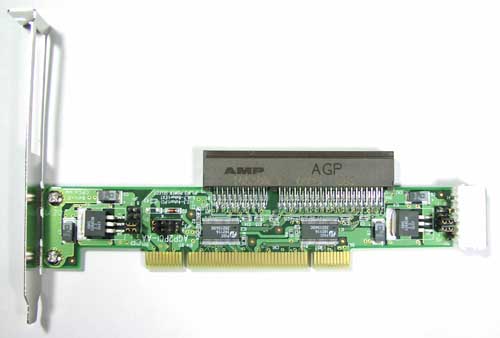
Now I'm not sure 100% what the attraction is of this adapter, but since a few V6K owners are using it I thought it would be prudent to include. In theory it allows you to run the V6K on ANY motherboard with a PCI slot but that limits you to a PCI spec 33 mhz bus. Unless of course your overclocking the machine (and need to run card at lower bus speed to keep from blowing HiNT chip to pieces) or have a motherboard with a PCI-x slot which will run at 66 mhz.
I'll try to obtain more information, this piece is only available through vendors in Japan.
Note- The V6K works properly under Win98/ME with this adapter utilizing the reference 3dfx drivers but not under Win2000/XP with current available drivers. Under 2000/XP the V5-6000 will only operate in single chip mode sources report, I'm told this is being looked into.
Note- It's been noted by one user he has utilized this adapter on an Abit NF7-S revision 2 (Nvidia nForce 2 chipset & Athlon XP) and a MSI K8T NEO revision 1 (VIA KT-800 & Athlon 64) with no problems.
In the BIOS settings, disable the following-
Video BIOS shadow or cache
VGA palette snoop or DAC snoop
Hidden refresh
Byte Merge
spread spectrum clocking
While your in the BIOS see if it has hardware monitoring of the AGP voltage and note if it is at the correct 3.3 volts required.
Hank Semenec quotes- "In the future make also sure that the spread spectrum clocking is turned off! The PCI PLLs in VSA-100 jitter a lot and spread spectrum is not helping."
Drivers
If using Windows 95/98 I have had no problems at all running the last 3dfx reference drivers. These drivers are also for use if your operating system is Windows ME but I have no information on how well the card runs under that operating system.
If running Windows 2000 or XP there are several third party drivers available from www.3dfxzone.it
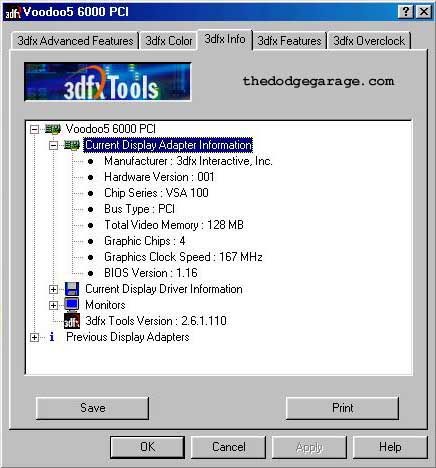
The 3dfx VSA-100 reference drivers for Win95/98 will identify the card as a Voodoo5 6000 PCI, this is normal and no cause for concern. Some third party drivers address this issue which is strictly cosmetic.
Popped diodes
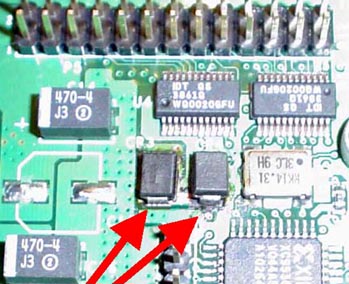
On some V6K it's noted that the diodes shown above are damaged.
According to Hank Semenec the diodes are there to prevent latchup from incorrect power sequencing. It keeps the FETs opened to the GND from core plane and the DIODES are connected to 3.3V and core plane, you get a short and burn up the FETs and DIODES.
The diodes pop due to a faulty power supply regulation chip not starting up. If the diodes are blown, then the SAMTECH power regulator must be replaced along with 8 transistors before replacing the damaged diodes.
Reverse polarity to the board will cause the regulator to blow, I'm trying to find out now if anything else will too.
V6K Trivia (Some from Hank Semenec, ex-3dfx troubleshooter and lab rat)
1) Daytona related - 3dfx had plans to make a V5-6000 utilizing Daytona chips. The Daytona chip was made with a smaller micron die process with lower power consumption and lower cooling requirements. The Daytona chips would run easily at 250+ mhz.
2) Color banding in 32bit color modes- The color banding issue is well known. The problem is that V5 6000 uses analog SLI and it was necessary to divide the final RGB result by 2 in 4xFSAA. If the division was not done then the final RGB out put would be 1.4V, double the allowed .7Volts. Divide by 2 in binary is shift right, so your 8 bit number becomes 7 bits only. b'1111 1111 becomes b'0111 1111. If you load the traditional 8 bit Gamma table you will run into trouble. The Gamma table has to be computed for 7 bits with 8th bit MSB ignored. I believe the problem was fixed already in Amigamerlin driver set 3.0
3) Another problem that exists is noise on DAC output from chip 4, there is a work around for that too. You can notice noise at fastest setting when all the chips are driving RGB.
4) I have to state this again, please do not flash the cards if they are working. 3DFX cards went through a bunch of different memory manufacturers, the cycle based timing in DramInit0 was adjusted to support that memory.
5) The backplate for the V5-6000 & V5-5500 is the same except for the hole added for the Voodoo Volts connector. The V4-4500 backplate is close but the upper support hole is in the wrong location.

6) Speaking of backplates- A few of the later V5-6000 floating around have been spotted with the early backplates installed. Clearly 3dfx either had not gotten around to producing the later backplate at the time the board was sent off for review or they were just using up the early backplates that were still on hand.
Quantum3D obtained the rights for using VSA-100 chips under SLI mode right before 3dfx closed their doors. But they never officially sold any systems with V5-6000 installed, just the AA5 systems with the 8 way AAlchemy boards. However Quantum3D DID use some V5-6000's at trade shows to show how anti-aliasing worked to customers as the screenshot above shows. (click for larger image)
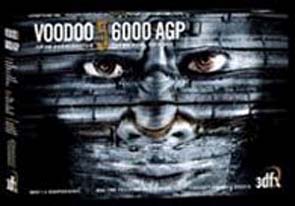
Actual image of V5-6000 box from 3dfx website, 2000.
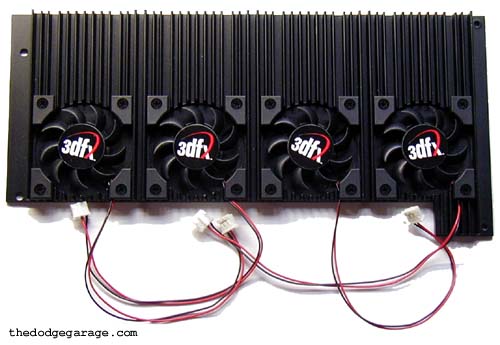
One interesting item related to the "Intel" revision V6K is this prototype fan set. It was obtained from a former engineer who indicated that a very small number of them had been made but none had ever been mounted to a board. It's not terribly surprising as it is a massive, burly piece and due to it's configuration only fits the "Intel" revision boards, which 3dfx worked with for only a short period of time.
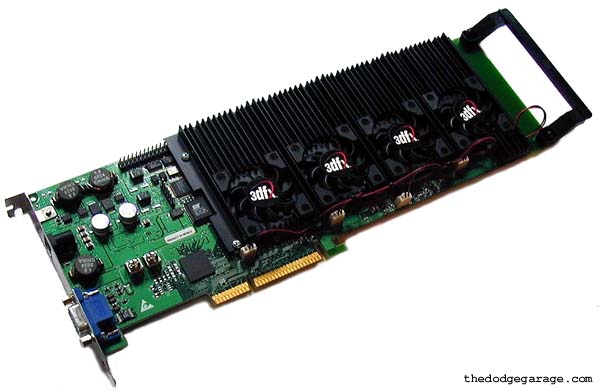
Unable to resist temptation and leave such a magnificent piece of hardware lying around, I sent the fan assembly to the patron saint of V6K's and had it installed. The V6K it is fitted to is a 3700-A with full PCI rework and worked perfect after a little massaging. Four of the feature connector pins up top had to be removed and a notch ground to clear the BIOS chip.
Thanks to those the contributed information, suggestions and proofing for the V6K FAQ, in no particular order: Hank Semenec, V-Man, Logical Madness, Oscar, Omega_Supreme, Jiri Soucek, Chosen_One, O.B. Kenobi, Thandor and those that made contributions via posts on various 3dfx forums.